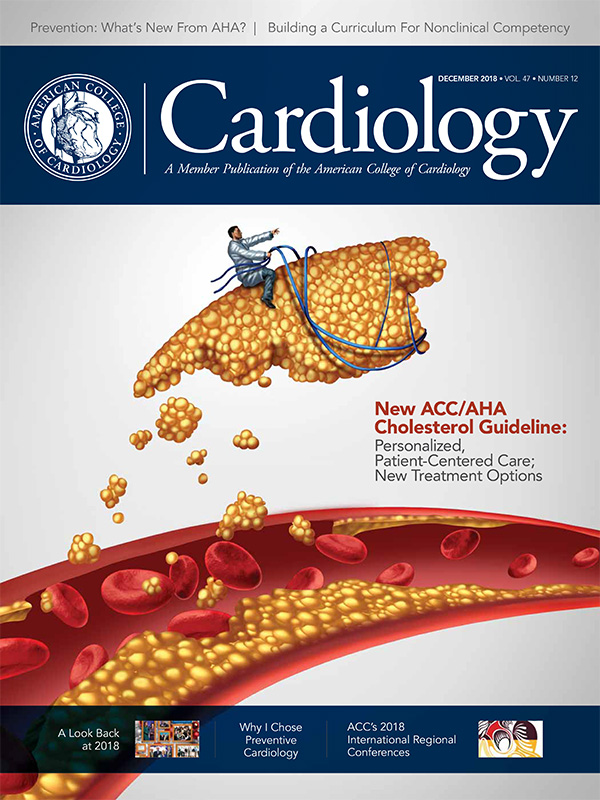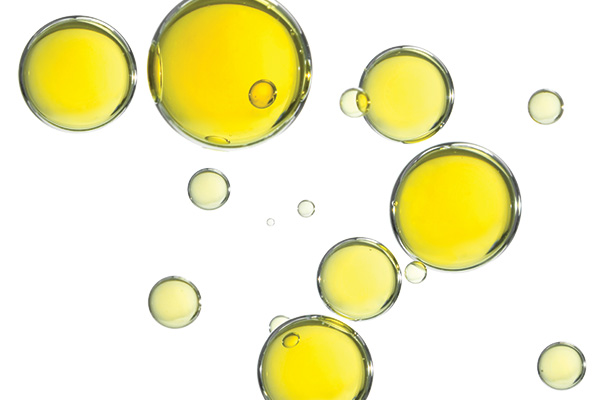Feature | Prevention: What's New For Our Patients From AHA 2018?
Surely we're all noticing that prevention of cardiovascular disease is now center stage at the key scientific meetings. No longer consigned to the farther reaches of the convention center, it's now the main event. The science of prevention has come a long way.
First up at this year's American Heart Association (AHA) Scientific Sessions in Chicago was the release of the ACC/AHA new guideline on blood cholesterol for atherosclerotic cardiovascular disease (ASCVD) risk reduction (see cover story).
 Pamela Bowe Morris, MD, FACC
Pamela Bowe Morris, MD, FACC
"The release of the new guideline and the abundance of late-breaking clinical trials (LBCTs) and new science in prevention made this meeting pivotal and practice changing," says Pamela Bowe Morris, MD, FACC, chair of ACC's Prevention of Cardiovascular Disease Section and vice chair of ACC's Scientific Session.
Arguably, the show stopper LBCTs were REDUCE-IT and VITAL, with physicians and patients alike reading confusing headlines about the benefit of fish oil. The bottom line is this: a highly purified, pharmaceutical-grade EPA-only fish oil at high dose was beneficial for secondary prevention in a selected population, while an over-the-counter Omega-3 at low dose was not beneficial for primary prevention in a general all-comers population.
REDUCE-IT: Does Icosapent Ethyl Represent New Pathway For Reducing CV Risk?

"The REDUCE-IT trial provides strong evidence of the benefits of the prescription omega-3 fatty acid, EPA, for reduction of residual risk among ASCVD patients with moderate hypertriglyceridemia on evidence-based statin therapy. These findings are likely to have an important impact on clinical practice," says Morris.
In what could represent a new pathway for cardiovascular risk reduction, findings from the REDUCE-IT trial show icosapent ethyl (2 g twice daily) significantly reduced the risk of major ischemic events, including cardiovascular death, in patients with elevated triglyceride levels despite statin therapy.1
Researchers, led by Deepak L. Bhatt, MD, MPH, FACC, randomized 8,179 patients with established cardiovascular disease (70 percent of study population) or with diabetes and another ASCVD risk factor (30 percent of study population) to receive either 2 g of icosapent ethyl twice daily or placebo (mineral oil). All patients were on statin therapy and had a fasting triglyceride level from 135 to 499 mg/dL and an LDL-C level from 41 to 100 mg/dL. At baseline, the median triglyceride was 216 mg/dL and the median LDL-C was 75 mg/dL.
The primary endpoint was a composite of cardiovascular death, nonfatal myocardial infarction (MI), nonfatal stroke, coronary revascularization or unstable angina. Over the median follow-up of 4.9 years, a primary endpoint event occurred in 17.2 percent of patients in the icosapent ethyl group vs. 22.0 percent in the placebo group (hazard ratio [HR], 0.75; 95 percent confidence interval [CI], 0.68-0.83; p<0.001). This translated to an absolute risk reduction (ARR) of 4.8 percent and a number needed to treat of 21 to avoid one primary endpoint event. The benefit was similar in patients with ASCVD and with diabetes.
The key secondary endpoint of a composite of cardiovascular death, nonfatal MI or nonfatal stroke was lowered by 26 percent in the icosapent ethyl group vs. placebo (11.2 percent vs. 14.8 percent event rate, respectively). This translated to an ARR of 3.6 percent and a number needed to treat of 28. Prespecified hierarchical testing of other secondary endpoints revealed, in part, a 20 percent lower risk of cardiovascular death, the authors said.
In other findings, overall rates of adverse events were similar in both groups, according to the investigators. However, serious adverse events related to bleeding (2.7 vs. 2.1 percent; p=0.06), as well as rates of hospitalization for atrial fibrillation or flutter (3.1 vs. 2.1 percent; p=0.004) were higher in the icosapent ethyl group vs. the placebo group, although in both cases rates were low.
From baseline to one year, the median change in triglyceride level was an 18.3 percent decrease with icosapent ethyl vs. a 2.2 percent increase with placebo and the median reduction from baseline was 19.7 percent greater in the icosapent ethyl group compared with placebo. Additionally, while the median change in LDL-C levels from baseline increased in both groups, there was a 6.6 percent lower increase in the icosapent ethyl group compared with placebo (3.1 percent vs. 10.2 percent).
 Michael Shapiro, DO, FACC
Michael Shapiro, DO, FACC
"REDUCE-IT is a remarkable achievement and gives us a reason to be enthusiastic that adding another evidence-based treatment for patients with ASCVD could provide substantial benefit," says Michael Shapiro, DO, FACC, chair of the Dyslipidemia and Familial Hypercholesterolemia Work Group of ACC's Prevention of Cardiovascular Disease Section.
Shapiro notes that REDUCE-IT studied a different patient population than the cardiovascular outcomes trials with PCSK9 inhibitors. And while the LDL-C levels have been driven lower in the PCSK9 inhibitor trials, there are diminishing returns with this approach, at least in those who have already achieved adequate LDL-C reduction.
"In garden variety ASCVD, there are many drivers of ASCVD and we need to address them in different ways," he adds. Addressing LDL-C will always be front and center, but after an individualized risk assessment, using highly purified EPA at 4 g daily in individuals similar to those enrolled in REDUCE-IT may offer another alternative for individualizing treatment, he adds.
Triglycerides played a role, "but the magnitude of triglyceride reduction does not explain the magnitude of cardiovascular benefit seen in REDUCE-IT," says Shapiro. Indeed, Bhatt, et al., hypothesize that mechanisms beyond triglyceride reduction may be at work because of the reduction in ASCVD events regardless of the attained triglyceride level.
As with all novel treatments, confirmatory trials are needed. The EVAPORATE trial with icosapent ethyl in Japan is examining change in coronary plaque over nine to 18 months and the RESPECT-EPA trial in Japan is studying a moderate-to-high dose of a pure EPA ethyl ester. The STRENGTH trial is perhaps most anticipated, likely in 2020, which is studying a combination EPA/DHA prescription fish oil at a dose of 4 g daily in a population similar with REDUCE-IT.
VITAL: No Benefit of Vitamin D, n-3 Fatty Acids on CV Events or Cancer

In a large primary prevention population, supplementation with vitamin D or marine n-3 fatty acids may not lower the incidence of major cardiovascular events or invasive cancer vs. placebo, according to results from the VITAL trial.2
JoAnn E. Manson, MD, PhD, et al., conducted a randomized, placebo-controlled trial with a 2x2 factorial design looking at 25,871 participants with a mean age of 67.1 years. Participants were randomized to a dose of 2,000 IU of vitamin D3 per day, and a dose of 1 g of n-3 fatty acid per day.
Results showed at a median follow-up of 5.3 years the primary endpoint of a major cardiovascular event (MI, stroke or death from cardiovascular causes) occurred in the vitamin D and matching placebo group in 396 and 409 participants, respectively, and in the n-3 and matching placebo group in 386 and 419 participants, respectively. Further, invasive cancer was diagnosed in 793 and 824 participants in the vitamin D and placebo groups, respectively, and in 820 and 797 participants in the n-3 and placebo groups, respectively.
In the n-3 vs. placebo group, there was a 7 percent reduction for the expanded secondary composite endpoint of cardiovascular events, 28 percent reduction in total MI, 4 percent reduction for death from cardiovascular causes and a 3 percent reduction in death from cancer, and a slight increase in stroke (HR, 1.04).
In the vitamin D vs. placebo group, there was a 4 percent reduction for the expanded composite endpoint of major cardiovascular events plus coronary revascularization, 4 percent reduction in MI, 5 percent reduction in stroke and an increase in death from cardiovascular causes (HR, 1.11).
"This important trial of vitamin D and omega-3 fatty acids confirms yet again that heart healthy nutrients are best obtained from whole foods and not from dietary supplements in a bottle," says Morris.
The authors note that a strength of their trial is a large general population sample with racial, ethnic group and geographic diversity. Further, they conclude that "[their] finding of a possible lower incidence of the primary cardiovascular endpoint with n-3 supplementation than with placebo among participants with low fish consumption – a characteristic that has rarely been examined as an effect modifier in previous trials – is hypothesis-generating."
They conclude that moving forward, "the results of ongoing trials that are testing higher doses in high-risk populations will be informative but may not apply to primary prevention."
In an editorial comment from John F. Keaney Jr., MD, FACC, and Clifford J. Rosen, MD, they write "Despite the negative findings regarding the primary endpoints in VITAL, the secondary end points will undoubtedly draw attention … these 'positive' results need to be interpreted with caution."
Ezetimibe Prevents ASCVD Events in Elderly With High LDL-C

Lipid-lowering monotherapy with ezetimibe may prevent the occurrence of a composite of ASCVD events in elderly patients with elevated LDL-C and no history of coronary artery disease show results from the EWTOPIA75 trial.
"In view of the growing numbers of older adults around the globe, the safety and efficacy of ezetimibe for primary prevention of ASCVD events is encouraging for this at-risk population," says Morris.
Yasuyoshi Ouchi, MD, PhD, et al., looked at 3,796 Japanese elderly patients aged 75 years old or older with no history of coronary artery disease, whose LDL-C level was ≥140 mg/dL and who had one or more cardiovascular risk factors. Patients were randomly assigned to the ezetimibe group of 10 mg/day plus diet counseling or the control group of diet counseling alone.
After five years, the primary endpoint of a composite of sudden cardiac death, fatal MI, nonfatal MI, coronary revascularization, fatal stroke, and/or nonfatal stroke was higher in the control group vs. the ezetimibe group. Ouchi et al., note that "lowering by ezetimibe monotherapy significantly prevented ASCVD events (HR, 0.66; p=0.002) in elderly patients with elevated LDL-C level."
The researchers state "the result obtained in this study is the first evidence suggesting that the primary prevention of atherosclerotic cardiovascular events is possible by lipid-lowering therapy for eligible older patients aged 75 years or older."
AKCEA-APO(a)-LRx Shows Promise of Reducing Lp(a) Levels in CVD

AKCEA-APO(a)-LRx – a second generation, N-acetyl-galactosamine-conjugated, antisense oligonucleotide targeted to apolipoprotein(a) – may reduce Lp(a) levels in patients with preexisting cardiovascular disease, according to results of the AKCEA trial.
Sotirios Tsimikas, MD, FACC, et al., looked at 286 patients with preexisting cardiovascular disease (coronary artery disease, MI, peripheral artery disease, stroke/transient ischemic attack) and baseline Lp(a) ≥60 mg/dL who were randomized to receive 20, 40 or 60 mg of AKCEA-APO(a)-LRx per month, 20 mg/every two weeks, or 20 mg per week, for a minimum of six months vs. placebo.
According to the investigators, AKCEA-APO(a)-LRx significantly and "dose-dependently" reduced Lp(a) levels, with "98 percent of patients achieving Lp(a) levels ≤50 mg/dL at the highest dose." They add that it also reduced OxPL-apoB, OxPL-apo(a), LDL-C and apoB levels. Further, a favorable safety profile was noted with no significant liver, renal or platelet adverse events vs. placebo.
Moving forward, they say this study "provides a rationale for the initiation of a phase 3 outcomes trial to test the 'Lp(a) hypothesis,' namely that lowering Lp(a) levels will reduce cardiovascular events."
Yoga to Improve QOL in Acute MI Patients? Yes.

The largest trial to date looking at cardiac rehabilitation and health benefits of yoga showed that it was safe, feasible and improved quality of life (QOL) and return to pre-infarct activities in acute MI patients.
The Yoga-CaRe trial, presented by Dorairaj Prabhakaran, MD, DM, et al., looked at 4,014 patients from 22 cardiac centers across India who were recruited after an acute MI and were randomized to the Yoga-CaRe program – 13 in-hospital sessions supervised by an instructor with encouragement to practice regularly at home – or enhanced standard care with three educational sessions.
No difference was found between the groups for the primary outcome of major adverse cardiovascular event (death, nonfatal MI, nonfatal stroke, emergent cardiovascular hospitalization (HR, 0.91). The researchers noted there were "numerically fewer outcomes in the Yoga-CaRe group, but not statistically significant," and that there was inadequate power to detect the planned difference due to a lower event rate than estimated.
For the co-primary endpoint of QOL at 12 weeks, the "improvement in the self-rated quality of life was significantly greater in the Yoga-CaRe group," they state.
The authors conclude that "Yoga-CaRe has the potential to be an alternative to the conventional cardiac rehab programs and address the unmet needs of cardiac rehabilitation for patients in low- and middle-income countries."
References
- Bhatt DL, Steg G, Miller M, et al. N Engl J Med 2018;Nov 10:[Epub ahead of print].
- Manson JE, Cook NR, Lee IM, et al. N Engl J Med 2018;Nov 10:[Epub ahead of print].
Clinical Topics: Arrhythmias and Clinical EP, Cardiovascular Care Team, Diabetes and Cardiometabolic Disease, Dyslipidemia, Prevention, Atherosclerotic Disease (CAD/PAD), SCD/Ventricular Arrhythmias, Atrial Fibrillation/Supraventricular Arrhythmias, Hypertriglyceridemia, Lipid Metabolism, Nonstatins, Novel Agents, Primary Hyperlipidemia, Statins, Diet
Keywords: ACC Publications, Cardiology Magazine, American Heart Association, Angina, Unstable, Apolipoproteins A, Apolipoproteins B, Atherosclerosis, Atrial Fibrillation, Blood Platelets, Cardiac Rehabilitation, Cardiovascular Diseases, Cholecalciferol, Cholesterol, Coronary Artery Disease, Death, Sudden, Cardiac, Diet, Diabetes Mellitus, Control Groups, Counseling, Dietary Supplements, Eicosapentaenoic Acid, Phenylphosphonothioic Acid, 2-Ethyl 2-(4-Nitrophenyl) Ester, Ethnic Groups, Fasting, Fatty Acids, Fatty Acids, Omega-3, Fish Oils, Galactosamine, Follow-Up Studies, Hospitalization, Hydroxymethylglutaryl-CoA Reductase Inhibitors, Hyperlipoproteinemia Type II, Hypertriglyceridemia, Ischemic Attack, Transient, Mineral Oil, Myocardial Infarction, Neoplasms, Numbers Needed To Treat, Oligonucleotides, Antisense, Peripheral Arterial Disease, Pharmaceutical Preparations, Primary Prevention, Quality of Life, Research Personnel, Risk Assessment, Risk Factors, Risk Reduction Behavior, Secondary Prevention, Stroke, Triglycerides, Vitamin D, Yoga
< Back to Listings






